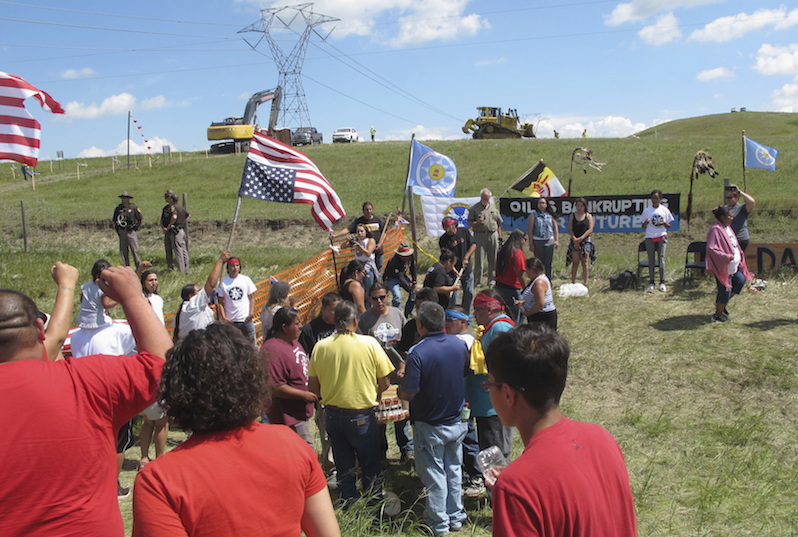Dakota Access Pipeline Protests Recall America’s Historical Shame
If indigenous activists manage to block the building of an oil line they consider a threat to ancestral lands, their success will be one small measure of justice in a line of injustices going back to the founding of this nation. Native Americans protest the Dakota Access oil pipeline near the Standing Rock Sioux reservation in southern North Dakota. (James MacPherson / AP)
Native Americans protest the Dakota Access oil pipeline near the Standing Rock Sioux reservation in southern North Dakota. (James MacPherson / AP)
Native Americans protest the Dakota Access oil pipeline near the Standing Rock Sioux reservation in southern North Dakota. (James MacPherson / AP)
Until a few years ago, the word “occupation” was synonymous with power, imperialism and foreign invasion. Today, in the post-Occupy Wall Street era, more and more activists are using their physical presence to make demands. From Manhattan’s Zuccotti Park to Tahrir Square in Cairo, occupation has become a powerful method of organizing.
One of the most dramatic such occupations is occurring in the form of a growing encampment at the Cannonball River in North Dakota, where indigenous tribes are leading a coalition of environmental activists in protest over the building of a new crude oil pipeline.
READ: Dakota Pipeline Would Make Water the New Oil, Devastating All but the Rich
The Dakota Access pipeline (DAPL) has stolen more than a name from American Indians (“dakota” means “friendly” or “allied”). If built, it would pass under the Missouri River twice. The pipeline, which could leak, as many pipelines do, threatens to contaminate the drinking water, crops and burial grounds of the Standing Rock Sioux tribe. Federal regulatory agencies, including the Army Corps of Engineers, quietly approved DAPL, which will transport Bakkan crude oil from North Dakota through South Dakota, Iowa and Illinois.
Last November, President Obama rejected the Keystone XL pipeline, which would have transported tar sands oil from Alberta, Canada, to the U.S. Gulf Coast. The rejection was the result of a years-long, hard-fought battle by thousands of activists, many of whom made personal sacrifices, traveled long distances and were even arrested for their acts of civil disobedience.
DAPL, which is only seven miles shorter than Keystone would have been, has not received the same scrutiny. Now, the only thing standing in the way of the pipeline is a growing army of nonviolent protesters blocking construction. An occupation that began in April has grown to about 2,000 and is still growing. Members of the Standing Rock Sioux have set strict rules at the space they are calling Sacred Stone Camp: No weapons, alcohol or drugs.
Members of other North American tribes, including Canadian First Nations, are traveling to the site in solidarity. Celebrities such as Leonardo DiCaprio, Shailene Woodley and Ezra Miller have lent their support. The protesters are standing firm, and more than 20 people have been arrested.
Jason Coppola, a filmmaker and journalist who has been covering the protests, explained in an interview with me that one of the most important aspects of this story is one that is age-old: The U.S. government is violating its treaty obligations to Native American tribes. According to Coppola, “The Fort Laramie Treaty of 1868 guaranteed complete and total access, undisturbed access, [of the land] to the Great Sioux Nation of the Oceti Sakowin [Seven Council Fires].” But that treaty has not been respected. The U.S. National Archives and Records Administration explains how—as a result of an expedition led in 1874 by Gen. George Armstrong Custer in search of gold on the Black Hills reservation in North Dakota—”[t]o this day, ownership of the Black Hills remains the subject of a legal dispute between the U.S. government and the Sioux.”
Coppola told me that it is “important to see this fight in the broader context,” because “the Lakota nation and its people have been fighting situations like this for a very long time.” The DAPL dispute is not just about a pipeline running under a river. It is, broadly speaking, about the rights of the original inhabitants of the United States.
At a time when white-supremacist notions are re-emerging and a major-party presidential candidate is encouraging America to hate again, this battle of government and corporate power against Native American rights is an important reminder of the real power dynamics in the U.S. and of who has been denied rights since the founding of the country.
READ: The People vs. the Bakken Pipeline in Iowa and the Dakotas
Earlier this year, a group of armed white men led by Ammon Bundy occupied the Malheur National Wildlife Refuge in Oregon for more than 40 days in protest of federal land ownership. Those occupiers, who garnered far greater mainstream media attention than the DAPL protesters, ignored the fact that the original stewards of the land they were claiming were members of the Burns Paiute tribe. In fact, the tribe fought for decades in court to gain rights to the land, only to be given a paltry few hundred dollars per person as compensation.
By contrast, the very people that the U.S. has historically sold out and continues to betray lead the occupation in North Dakota. Just as it served the needs of white settlers in decades past, the government is putting corporate power and fossil fuel interests over Native American rights in the case of the DAPL project.
Energy Transfer Partners, the company building the pipeline, has launched a website with the innocent-sounding name of daplpipelinefacts.com. On it, the company touts seemingly optimistic economic gains, including the creation of “8,000 to 12,000 construction jobs” (contrasted with a mere “40 permanent operating jobs”). It echoes the standard claim of “energy independence” by liberal politicians, saying that the pipeline will help the U.S. be “truly independent of energy from unstable regions of the world,” because “every barrel of crude oil produced in the United States directly displaces a barrel of imported foreign oil.”
Under the “frequently asked questions” section, the website asks: “What is Dakota Access Pipeline’s commitment to protecting sensitive areas and the environment, such as wetlands and culturally important sites?” The lengthy answer addresses only concerns such as restoring seed banks and vegetative cover, but says nothing about the “culturally important sites” that it raises in its own question. The rest of the page focuses mostly on the concerns of private landowners. There is no mention whatsoever of the Standing Rock Sioux tribe. It is as if the tribe does not exist.
Obama claimed to set his administration apart from previous ones by partnering with Native American communities. He has made it a point to visit reservations, a rare act by presidential standards. In 2014, during a visit to North Dakota, he said he was “determined to partner with tribes … on just about every issue that touches your lives.” Indeed, his rejection of the Keystone XL pipeline could be viewed in light of that partnership (Oglala Sioux leader Bryan Brewer called Keystone “a death warrant for our people” during Obama’s visit). In the last few months of Obama’s administration, it remains to be seen whether it will intervene to stop the DAPL despite the approval of federal permits.
Regardless, indigenous activists are determined to occupy their own land for as long as it takes to stop construction of the pipeline. If they succeed, it will be one small measure of justice in a line of injustices going back to the founding of this nation.
Your support matters…Independent journalism is under threat and overshadowed by heavily funded mainstream media.
You can help level the playing field. Become a member.
Your tax-deductible contribution keeps us digging beneath the headlines to give you thought-provoking, investigative reporting and analysis that unearths what's really happening- without compromise.
Give today to support our courageous, independent journalists.






You need to be a supporter to comment.
There are currently no responses to this article.
Be the first to respond.